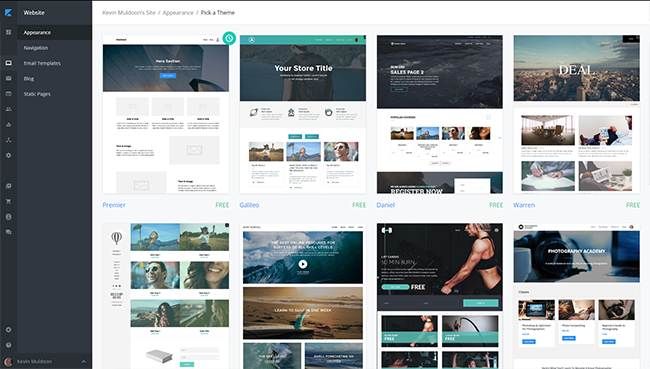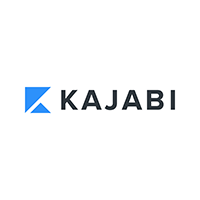Kajabi is a premium service that lets you create online courses and membership websites.
With their basic plan working out at an effective rate of $103 per month if you choose to pay annually, Kajabi is clearly not marketed at the lower end of the market; however the service does give you a lot for your money.
It gives you templates, landing pages, marketing tools, blogs, analytics, and integration with third party services. All payments are handled through Kajabi and you can use your own domain name. You won’t need to worry about hosting as Kajabi handles that too.

When you choose to sell courses online you can decide to either build everything yourself by creating a website and using a custom solution or a range of third party products or you can let a company like Kajabi handle everything. There are pros and cons to each method, but obviously if you are someone who wants full control over everything, Kabaji isn’t for you as your whole business will be tied to the Kajabi service. Being hosted does mean, however, that everything ties in together well.
Check out my video below to see what the service offers.
If you would prefer to read my thoughts about Kajabi, keep reading to get an insight into the member area of the service and see how it can be used to create online courses and membership websites.
Creating Online Courses with Kajabi
* Please be aware that I have not used Kajabi on a live website. I have familiarised myself with all of the service’s features through the dashboard area. Everything seems to work fine, but it is not until you have used a service on a live website that you get to understand what works well and what does not.
The Kabaji interface works really well. You can navigate all of the main areas using the navigation area on the left-hand side of the page.
Under Marketing you will find Website, Email Marketing, Landing Pages, People, Reports, Integrations, and Settings. Under Store you will find Products, Sales, Affiliates, and Comments. At the bottom of the menu are links to achievements, help, and your member area.

There are eleven themes to select as the main design of your website. I would like to see more designs available, but the quality of the ones there just now are very high. Plus it is important to remember that themes can modified once you have selected them. Themes can be exported and uploaded later too.

The theme editor looks very similar to the WordPress theme customizer, however it does not offer live previews of the changes you make. Instead, you need to save them and then the page will reload.
You can change everything on the page, from colours to forms to headings. It works really well, though you do need to work within what is offered.

You can select from several email templates, create static pages for your website, and add blog posts. Without a doubt, Kajabi has drawn inspiration from WordPress again as the blog post editor looks exactly as it does in WordPress. That’s not a bad thing as it is very easy to use.

In the email marketing section you can create email broadcasts. Email sequences will let you setup emails and schedule them at certain times after someone has opted into your course newsletter.
23 landing page templates are available. There is a good variety of templates available to suit a wide range of topics. Once you have chosen a landing page and a style, you can customise it and optimise it to maximise sign ups for your course.

I like how Kajabi handles product creation.
You can add posts and assign posts to categories. In posts you can upload videos up to 2GB in size and add written content. Files can be uploaded for download too. For example, you could add a series of eBooks to a page and offer those to customers.
The product page can be styled using a theme editor. You can add multiple products and style them differently. It’s up to you.

If you want to get a better feel for how you use Kabaji to create an online course or membership website, please watch my video review.
The Cost of Kajabi
Kajabi offers three different plans: Basic, Pro, and Premium.
If you choose to pay annually, you will save 20%. Basic costs $129 per month or an effective rate of $103 per month if you pay annually. Pro costs $311 per month or an effective rate of $389 per month if you pay annually. Finally we have the premium plan which costs $899 per month or an effective rate $719 per month if you pay annually.

The basic plan allows you to sell five products through one website. You are permitted 1,000 marketing emails per month, one admin user, 1,000 active members (customers), and 25 landing pages. The theme customisation editor is provided, you can drip content to members, and you gain access to the Kajabi university training courses.
Going up to the pro plan increases limits to 100 products, 40,000 marketing emails, five admin users, 10,000 active members, and three websites. This plan also unlocks the option for the affiliate program, lets you remove the Kajabi credit link, and adds live chat support.
The premium plan offers the same features as the pro plan but increases limits to unlimited products, 100,000 marketing emails, 25 admin users, and 10 websites.

Kajabi offer a 30 day money back guarantee and you can cancel your service at any time.
A 14 day free trial is available to let you test their service. Unfortunately, they require you to enter your credit card details in order to test the service. This disappoints me as I always believe that a service should be opt-in at the end of a trial, not opt-out.
One reason companies such as Kajabi require customers to enter their credit card information is to reduce the number of time wasters. By asking for payment information right away I have no doubt they reduce the number of customer support issues from people who were unlikely to pay up at the end of the trial.
Making a Profit with Kajabi
Make no mistake, Kajabi requires you to make a big commitment to your online courses and membership website. They are looking for people who are looking to invest in their online course, not people who are just testing the waters.
Their pricing reflects this.
On a yearly basis their basic plan will cost $1,236 if you pay annually or $1,548 if you pay monthly. The pro plan costs $3,732 if you pay annually or $4,668 if you pay monthly. Their premium plan costs $8,628 if you pay annually or $10,788 if you pay monthly.
The higher priced plans may seem expensive to some of you, but it is worth noting that the pro and premium plans are geared to people who run multiple courses so the customers who select those plans will already have a successful membership website under their belt.
If you are serious about building a membership website, my advice would be to use the free trial for 14 days to test the service and then stick with the monthly plan for the first two or three months. This will allow you to build your membership website, market it, and more importantly, cancel your membership if the project does not prove to be successful. You will be paying an additional $26 per month by choosing to pay monthly rather than yearly, but if you choose to cancel your membership later this is a better choice than paying $1,236 up front for 12 months.
So how do you make a profit with Kajabi?
Firstly, you need to provide good content and deliver a solid product to customers. This gives people a reason to buy your course.
Pricing your course is not an exact science. It will depend on how good your course is, how unique the content is, whether customers have other options, and whether you have a existing blog or website which you can use to market the course.
The good thing about using a hosted service such as Kajabi is that you know all of the costs up front. Apart from the standard Stripe merchant processing fee of 2.9% + 30 cents per transaction, Kajabi does not take any of your profits. This means that there will be no surprises as to what your expenses will be.
You will know in the first month that you need to pay $129 per month and can plan your marketing strategy appropriately.
For example, if you sell your course at $29 then you will know that after five sales every month you will have generated $145 in sales less $1.65 in transaction fees. This break-even point of five sales will leave you with $14.35 profit and any additional sales after that will be all profit.
If you sold the course at a higher price point, such as $199, you would break even after just one sale.
The reason I am explaining all of this is to remind you all that price is subjective. Those of you who are used to paying $49 for a WordPress plugin may think that the cost of Kajabi is obscene, but if you plan everything correctly from the start and price your course sensibly you can make a good profit.
You can build an online membership website cheaper. The reason you pay a premium to use a service such as Kajabi is because they handle everything for you.
On a day to day basis you do not have to deal with hosting issues, website administration problems, or design issues. You can focus all your time on creating good content and marketing your course. That is why Kajabi is going to be so appealing to many people.
Final Thoughts
Kajabi is an all in one solution that gives you everything you need to sell courses online and make money.
I was really impressed with what it can do. Being a hosted service, you do need to work within the features that are offered to you, but every major feature you need to create a good online course and drive customers to it are there.
Just be sure to backup everything you add to your course offline on your computer and to a cloud service such as Dropbox as there is no export functionality for your content. Doing that ensures that you can migrate to a custom self-hosted solution in the future if you desire.
The Kajabi Heroes page has dozens of examples of how Kajabi customers are using the service to make a lot of money online. The page highlights customers who have earned at least $1,000 from selling content through Kajabi.
Hereoes include Tiffany Bymaster Tiffany Bymaster from Lights Camera Branding, Kim Eagle from Shock That Body, Chris Kelly from Registered Behavior Technician Training, and Russ Perry from Design Pickle. If you choose to use Kajabi, I highly recommend browsing through the websites of existing customers to see how they are using the service to make money.
To find out more about Kajabi, check out the official website and be sure to watch my video review to get a closer look over the service.
Thanks for reading.
Kevin

